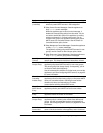
Chapter 4 Configuring the Appliance 31
Configuring NNTP
The NNTP section lets you configure basic NNTP options. While this section
lets you configure basic options, you must use the command-line interface to
configure the appliance to cache articles from particular NNTP servers and news
groups as well as to set access restrictions and authentication requirements for
news readers. See Configuring NNTP servers‚ on page 65 for more information.
Activity
timeout
Inbound
Specifies the maximum time the appliance should remain
connected to a user. If the user does not finish making a
request (reading and writing data) before this timeout expires,
the appliance closes the connection.
The user can close the connection at any time.
Activity
Timeout
Outbound
Specifies the maximum time the appliance should wait for
fulfillment of a connection request to a Web server. If the
appliance does not establish a connection to a Web server
before this timeout expires, the appliance terminates the
connection request.
The Web server can close the connection at any time.
Remove the
following
common
headers
Specifies headers for removal. Removing headers can protect
the privacy of your site:
❚ The From header. This header identifies the user’s e-mail
address
❚ The Referer header. This header identifies the Web link
followed by the user.
❚ The User-Agent header. This header identifies the
agent—usually a browser—making the request.
❚ The Cookie header. This header is often used to identify
the user making a request.
Insert Client-ip Insert Client-ip headers to retain client IP addresses.
Remove
Client-ip
Remove Client-ip headers for more privacy.
User
Language
Selects the language in which messages to the user from the
appliance are displayed. The default language is English.
Option Definition (Continued)


















